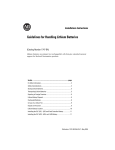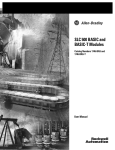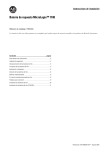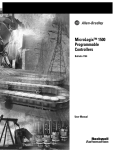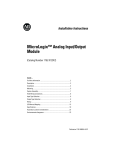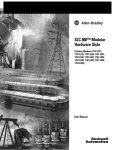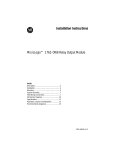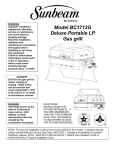Download DH485/RS-232C Interface Module
Transcript
Installation Instructions DH485/RS-232C Interface Module Catalog Number 1747-KE Inside . . . For See Page Important User Information 2 Hazardous Location Considerations 3 Environnements dangereux 3 About the DH485/RS-232C Module 4 Before You Begin 4 Configure the CONFIG Port 10 Configure the DF1 Port 10 Install the Interface Module 11 Wire the CONFIG and DF1 Communication Ports 12 Wire to the DH485 Port 15 Apply Power to Your DH485/RS-232C Module 16 Battery Replacement, Handling, Storage, and Transportation (Cat. No. 1747-BA) 16 Specifications 21 Additional Resources 23 Publication 1747-IN006B-EN-P - October 2005 2 DH485/RS-232C Interface Module Important User Information Solid state equipment has operational characteristics differing from those of electromechanical equipment. Safety Guidelines for the Application, Installation and Maintenance of Solid State Controls (Publication SGI-1.1 available from your local Rockwell Automation sales office or online at http://www.literature.rockwellautomation.com) describes some important differences between solid state equipment and hard-wired electromechanical devices. Because of this difference, and also because of the wide variety of uses for solid state equipment, all persons responsible for applying this equipment must satisfy themselves that each intended application of this equipment is acceptable. In no event will Rockwell Automation, Inc. be responsible or liable for indirect or consequential damages resulting from the use or application of this equipment. The examples and diagrams in this manual are included solely for illustrative purposes. Because of the many variables and requirements associated with any particular installation, Rockwell Automation, Inc. cannot assume responsibility or liability for actual use based on the examples and diagrams. No patent liability is assumed by Rockwell Automation, Inc. with respect to use of information, circuits, equipment, or software described in this manual. Reproduction of the contents of this manual, in whole or in part, without written permission of Rockwell Automation, Inc., is prohibited. Throughout this manual, when necessary, we use notes to make you aware of safety considerations. WARNING IMPORTANT ATTENTION Identifies information about practices or circumstances that can cause an explosion in a hazardous environment, which may lead to personal injury or death, property damage, or economic loss. Identifies information that is critical for successful application and understanding of the product. Identifies information about practices or circumstances that can lead to personal injury or death, property damage, or economic loss. Attentions help you identify a hazard, avoid a hazard and recognize the consequences. SHOCK HAZARD Labels may be located on or inside the equipment (for example, drive or motor) to alert people that dangerous voltage may be present. BURN HAZARD Labels may be located on or inside the equipment (for example, drive or motor) to alert people that surfaces may be dangerous temperatures. Publication 1747-IN006B-EN-P - October 2005 DH485/RS-232C Interface Module 3 Hazardous Location Considerations This equipment is suitable for use in Class I, Division 2, Groups A, B, C, D or non-hazardous locations only. The following WARNING statement applies to use in hazardous locations. ATTENTION WARNING: EXPLOSION HAZARD Substitution of components may impair suitability for Class I, Division 2. Do not replace components or disconnect equipment unless power has been switched off. Do not connect or disconnect components unless power has been switched off. All wiring must comply with N.E.C. article 501, 502, 503, and/or C.E.C. section 18-1J2 as appropriate. Environnements dangereux Cet équipement est conçu pour être utilisé dans des environnements de Classe I, Division 2, Groupes A, B, C, D ou non dangereux. La mise en garde suivante s’applique à une utilisation dans des environnements dangereux. ATTENTION AVERTISSEMENT: DANGER D’EXPLOSION La substitution de composants peut rendre cet équipement impropre à une utilisation en environnement de Classe 1, Division 2. Ne pas remplacer de composants ou déconnecter l'équipement sans s'être assuré que l'alimentation est coupée. Ne pas connecter ou déconnecter des composants sans s'être assuré que l'alimentation est coupée. Publication 1747-IN006B-EN-P - October 2005 4 DH485/RS-232C Interface Module About the DH485/RS-232C Module The DH485/RS-232C interface module, catalog number 1747-KE, is a communication interface module that acts as a bridge between DH485 networks and devices requiring DF1 protocol. The DF1 port on the interface module can be configured for RS-232/423, RS-422, or RS-485 devices. Residing in an SLC 500 chassis, the module is ideally used as an interface module, linking remote DH485 networks via a modem to a central host. Figure 1 Interface Module Placement on SLC 500 Chassis SLC 500 Controller 1747-AIC Link Coupler 1747-C11 Cable Before You Begin Before you begin to install the module, you need to: • identify the communication ports, • locate the LED indicators, and • set the module jumpers. Identify the Communication Ports There are three communication ports on the front of the DH485/RS-232C interface module. They are: • CONFIG • DF1 • DH485 The CONFIG port is used to configure the module with an ASCII terminal. This port is a serial port that accommodates RS-232/423, RS-422, and RS-485 communication modes. The CONFIG port is capable of operating full-duplex at 300, 600, 1200, 2400, 4800, 9600, and 19200 Kbps. It is electrically isolated to 500V dc. Publication 1747-IN006B-EN-P - October 2005 DH485/RS-232C Interface Module 5 The DF1 port is used to interface the module with user devices or a modem using DF1 protocol. This port is a serial port that accommodates RS-232/423, RS-422, and RS-485 communication modes. The DF1 port is capable of operating full-duplex at 300, 600, 1200, 2400, 4800, 9600, and 19200 Kbps. It is electrically isolated to 500V dc. The DH485 port is used to interface the module with the DH485 network. This port is not isolated and cannot directly drive a multi-node DH485 network. You must use a 1747-AIC link coupler to link port DH485 with the DH485 network that includes multiple SLC 500 controllers. Refer to Figure 2 for the location of the communication ports. Locate the LED Indicators There are eight LED indicators on the front of the module. These LED indicators are used for module diagnostics and status indication. Refer to Figure 2 for the location of the LED indicators. Figure 2 Communication Ports and LED Indicators DH485/RS-232C LED Indicators DH-485/RS-232C ACT FAULT 485 CFG BA LOW H/D DF1 F/D INTERFACE CONFIG Port 5 4 3 2 1 DF1 Port DH485 Port 9 8 7 6 CONFIG 5 4 3 2 1 9 8 7 6 DF1 DH485 Publication 1747-IN006B-EN-P - October 2005 6 DH485/RS-232C Interface Module LED Color Status Indication ACT Green ON(1) The module is receiving power from the backplane, is configured correctly, and is in the Run mode. Flashing The module requires configuration or is being configured. OFF The module is not receiving power from the backplane. A fault condition exists. ON Port DH485 on the module is active for communication. OFF Port DH485 on the module is not active for communication or the module is in Configuration mode. Flashing The CONFIG port on the module is transmitting or receiving signals. OFF The CONFIG port on the module is not transmitting or receiving signals. Flashing The DF1 port on the module is transmitting or receiving signals. The flashing may occur rapidly so the LED indicator appears to be on. OFF The DF1 port on the module is not transmitting or receiving signals or the module is in Configuration mode. ON A system problem was detected during background diagnostics. Cycle power to reset. Contact your local Rockwell Automation representative if the LED indicator remains on. OFF No system problems are detected during background diagnostics. ON The voltage of the battery that backs up RAM is low. A new battery is needed. OFF The voltage of the battery that backs up RAM is at an acceptable level. ON The module is configured for half-duplex DF1 protocol (local or remote). OFF The module is not configured for half-duplex DF1 protocol. ON The module is configured for full-duplex DF1 protocol. OFF The module is not configured for full-duplex DF1 protocol. 485 CFG DF1 Green Green Green FAULT Red BA LOW Red H/D F/D (1) Amber Amber Indicates normal operation after the module has been configured. Set the Module Jumpers The module have three sets of jumpers that you need to set. Jumper JW1 lets you select the communication interface for the CONFIG port. Jumper JW2 lets you select the communication interface for the DF1 port. Jumper JW4 lets you select the Publication 1747-IN006B-EN-P - October 2005 DH485/RS-232C Interface Module 7 functionality and mode of the interface module. The horizontal or vertical orientation of the jumper determines the module’s functionality. The position of the jumper determines the module’s mode (Configuration or Run), and thus, which method is used to configure the module (ASCII terminal or backplane communications). Figure 3 Jumper Locations JW1 CAT FRN SLC 500 INTERACE MODULE SER SERIAL NO. 54 3 2 1 CONFIG 9 87 6 54 3 2 1 DF1 9 87 6 JW4 DH485 Battery JW2 ATTENTION Do not expose the module to surfaces or other areas that may typically hold an electrostatic charge. Electrostatic charges can alter or destroy memory. ATTENTION Settings other than those shown for each jumper may cause damage to the module. Publication 1747-IN006B-EN-P - October 2005 8 DH485/RS-232C Interface Module Use a Modem with Your Interface Module The interface module can be connected to the following direct connect modems. • • • • Manual Data Terminal Equipment (DTE) Controlled Answer Auto Answer Direct Connect The manual modem is usually an acoustically-coupled modem. A person on each end of the phone line establishes the connection. The handset is inserted into an acoustic coupler to complete the connection. A DTE Controlled Answer modem is attached directly to the phone lines. The interface module acts as the DTE, which controls the modem via the DTR, DSR, and DCD signals. The module incorporates time-outs and tests to properly operate these types of modems. An Auto Answer modem has self-contained time outs and tests. They can answer and hang up the phone automatically. The module has no means of controlling an auto-dial modem, but it can be used in conjunction with a separate auto–dialer. A Direct Connect modem connects to a dedicated, leased phone line and remains active at all times. Choose the Module’s Functionality Your series B interface module has the ability to function as a series A interface module. This feature is useful if you are replacing a series A module with a series B module. The module’s functionality depends on the placement of the JW4 jumper. Horizontal placement of the jumper gives the module functionality equivalent to a series A interface module, while vertical placement of the jumper accesses the added functionality of a series B interface module. Refer to page 7 for location of jumper JW4. Figure 4 Module Functionality Series A Functionality (mod. config. ID=4209) Horizontal Configuration Mode Horizontal Run Mode Publication 1747-IN006B-EN-P - October 2005 Series B Functionality (mod. config. ID=3509) Vertical Configuration Mode Vertical Run Mode DH485/RS-232C Interface Module 9 Set the Module’s Functionality Setting the module’s mode depends on which method you want to use to configure the module. You can configure the module using an ASCII terminal or backplane communication. IMPORTANT You can only use backplane communications if you selected series B functionality for the module. Configure the Module with an ASCII Terminal Configure the interface module with an ASCII terminal only when the JW4 jumper is in Configuration mode. Place the module in the Configuration mode that corresponds to the functionality you chose for the interface module, as shown below. Refer to page 7 for location of jumper JW4. Figure 5 JW4 Jumper Set for Configuration Mode Series A Functionality Horizontal Configuration Mode Series B Functionality Vertical Configuration Mode Configure the Module via the Backplane Read and write configuration data through the backplane with series B interface modules, and then only when the JW4 jumper is in the vertical Run mode position. Place the module in vertical Run mode as shown below. Refer to page 7 for location of jumper JW4. Figure 6 JW4 Jumper Set for Vertical Run Mode JW4 Vertical Run Mode Publication 1747-IN006B-EN-P - October 2005 10 DH485/RS-232C Interface Module ATTENTION Other jumper settings are invalid and may cause damage to the interface module. Configure the CONFIG Port Jumper JW1 selects the following electrical interface for the CONFIG port. • RS-232/423 (default) • RS-422 • RS-485 Figure 7 JW1 Jumper Configurations RS-423/232 2 4 6 8 10 1 3 5 7 9 RS-422 JW1 CONFIG Port RS-485 Configure the DF1 Port Jumper JW2 selects the following electrical interface for the DF1 port. • RS-232/423 (default) • RS-422 • RS-485 Figure 8 JW2 Jumper Configurations RS-423/232 9 7 5 3 1 RS-485 10 8 6 4 2 JW2 DF1 Port RS-422 Publication 1747-IN006B-EN-P - October 2005 DH485/RS-232C Interface Module 11 Install the Interface Module Your interface module may be installed in any open slot of an SLC 500 1746 I/O chassis except the first slot of the first chassis. The first slot is reserved for the controller or adapter module. The interface module can also be installed in an SLC fixed controller expansion chassis. ATTENTION Never install, remove, or wire any module while power is applied. Also, do not expose the modules to surfaces or other areas that may typically hold an electrostatic discharge. Electrostatic discharge can damage integrated circuits or semiconductors if you touch backplane connector pins. If the equipment is not installed and used as described in the SLC 500 Modular Hardware Style User Manual, publication 1747-UM011, the protection provided by the equipment may be impaired. 1. Turn off power to the chassis where you will insert the module. 2. Align the circuit board of the module with the card guide of a slot (except slot 0) in the 1746 chassis. Figure 9 Module Location in the Chassis Module Release Card Guide 3. Slide the module in until the top and bottom retainer clips are secured. Publication 1747-IN006B-EN-P - October 2005 12 DH485/RS-232C Interface Module Wire the CONFIG and DF1 Communication Ports The CONFIG and DF1 ports communicate to user devices through RS-232/423, RS-422, and RS-485 communication modes. The communication mode you select depends on the setting of jumpers JW1 and JW2. Pin Assignments Use these pin assignments to wire the mating connector of the cable used to interface a user device to CONFIG and DF1 ports. The sockets of this connector must be wired to correspond to the selected communication mode. Pin RS-232/423 RS-422 RS-485 IBM AT Standard RS-232/423 Signal 25-pin 9-pin 1 (1) TXD - TRXD - DCD or CD 8 1 2 RXD RXD - (3) RXD 3 2 3 TXD (2) (2) TXD 2 3 4 DTR (2) (2) DTR 20 4 5 COMMON COMMON COMMON COMMON 7 5 6 DSR RXD + (3) DSR 6 6 7 RTS (2) (2) RTS 4 7 8 CTS (2) (2) CTS 5 8 9 (1) TXD + TRXD + RI 22 9 (1) In RS-423 mode, these pins are still connected to their RS-422 loads. Do not use these pins in RS-423 mode. (2) In RS-422 and RS-485 modes, these pins are connected to their RS-423 drivers and receivers. Do not use these pins in either RS-422 or RS-485 mode. (3) In RS-485 mode, these pins are still connected to their RS-422 receivers. Do not use these pins in RS-485 mode. IMPORTANT The signal names on a DCE device are viewed from a DTE perspective. For example, TXD is a DTE output and also a DCE input. The following illustrations show wiring diagrams for the RS-232/423, RS-422, and RS-485 communications. Publication 1747-IN006B-EN-P - October 2005 DH485/RS-232C Interface Module 13 Figure 10 RS-232/423 DTE to DCE (Non-modem Hardware Handshake to DCE) NC 1 CD 1 8 RXD 2 3 4 RXD 2 3 4 3 2 20 5 6 7 6 7 8 9 4 5 22 TXD DTR TXD DTR 5 6 COM DSR COM DSR 7 8 9 RTS CTS NC RTS CTS RI Figure 11 RS-232/423 DTE to DCE (Modem Hardware Handshake to DCE) NC 1 CD 1 8 RXD 2 3 4 RXD 2 3 4 3 2 20 5 6 7 6 7 8 9 4 5 22 TXD DTR COM DSR RTS CTS NC TXD DTR 5 6 COM DSR 7 8 9 RTS CTS RI Figure 12 RS-232/423 DTE to DCE (No Handshake to DCE) NC 1 CD 1 8 RXD RXD COM 2 3 4 5 COM 2 3 4 5 3 2 20 7 DSR 6 DSR 6 6 RTS 7 8 9 RTS 7 8 9 4 5 22 TXD DTR CTS NC TXD DTR CTS RI (1) (1) (1) Connect DSR to DTR and CTS to RTS when using devices that cannot disable their hardware handshaking. Publication 1747-IN006B-EN-P - October 2005 14 DH485/RS-232C Interface Module Figure 13 RS-232/423 DTE to DCE (Soft or No Handshake to DCE) NC 1 CD 1 8 RXD 2 RXD 2 3 TXD 3 4 TXD DTR DTR 3 4 2 20 COM 5 COM 5 7 DSR 6 DSR 6 6 RTS 7 8 9 RTS 7 8 9 4 5 22 CTS NC CTS RI (1) (1) (1) Connect DSR to DTR and CD, and CTS to RTS when using devices that cannot disable their hardware handshaking. Figure 14 RS-422 TXD- 1 RXD- RXD- 2 TXD- 3 4 COM 5 COM RXD+ 6 TXD+ TXD+ 7 8 9 RXD+ 1 TRXD- Figure 15 RS-485 TRXD- 2 3 4 COM 5 COM 6 TRXD+ 7 8 9 Publication 1747-IN006B-EN-P - October 2005 TRXD+ DH485/RS-232C Interface Module 15 Wire to the DH485 Port The DH485 port can communicate to user devices through the DH485 Communication mode. Use a 1747-C10, 1747-C11, or 1747-C13 interface cable to connect the module to a link coupler interfaced with the DH485 network. If you use the 1747-C10 or 1747-C11 cable, it connects between the DH485 port on the interface module and the J1 (CPU) connector on the link coupler. Power for the link coupler comes from the interface module. Figure 16 Wire to the DH485 Port via 1747-C10 and 1747-C11 Cable Link Coupler (1747-AIC) Interface Module (1747-KE) CONFIG Port DF1 Port J1 (CPU) DH485 Port Cable (1747-C11) (comms or power) If you use the 1747-C13 cable, connect it between the DH485 port on the interface module and the J2 (Peripheral) connector on the link coupler. Power for the link coupler must be provided from the SLC 500 module DH485 port or external power source. Figure 17 Wire to the DH485 Port via 1747-C13 Cable Link Coupler (1747-AIC) Interface Module (1747-KE) CONFIG Port J1 (Peripheral) DF1 Port J1 (CPU) Cable (1747-C11) DH485 Port Cable (1747-C13) Publication 1747-IN006B-EN-P - October 2005 16 DH485/RS-232C Interface Module The 1747-C13 cable can also connect the interface module’s DH485 port directly to a single SLC controller or fixed controller. It connects the DH485 port on the module to the DH485 port on the SLC 500 controller. Figure 18 Interface Module Connected to SLC 500 Controller SLC Controller Interface Module (1747-KE) Cable (1747-C13) DH485 Port Apply Power to Your DH485/RS-232C Module Once you have installed your DH485/RS-232C interface module in your SLC 500 system, you are already to apply power to your SLC 500 system. Battery Replacement, Handling, Storage, and Transportation (Cat. No. 1747-BA) Your module provides back-up power for RAM through a replaceable lithium battery (cat. no. 1747-BA). This battery provides back-up for approximately five years. A BAT LOW indicator on the front of the module alerts you when the battery voltage has fallen below the replace battery threshold level. Publication 1747-IN006B-EN-P - October 2005 DH485/RS-232C Interface Module 17 To replace the lithium battery: 1. Remove power from the SLC 500 power supply. ATTENTION Do not remove the module from the SLC 500 chassis until all power is removed from the SLC 500 power supply. 2. Remove the module from the chassis by pressing the retainer clips at the top and bottom of the module. IMPORTANT If the top or bottom retainer clips are broken while removing the module from the chassis, they can be easily replaced. Pry off any broken clips from the bottom with a screwdriver, if necessary. Do not twist off. Snap in the replacement clip. Order cat. no. 1746-R15 (two per package). ATTENTION Do not expose the module to surfaces or other areas that may typically hold an electrostatic charge. Electrostatic charges can alter or destroy memory. Figure 19 Battery Location CAT FRN SLC 500 INTERACE MODULE SER SERIAL NO. 54 3 2 1 CONFIG 9 87 6 54 3 2 1 DF1 9 87 6 DH485 Red Wire White Wire Battery Publication 1747-IN006B-EN-P - October 2005 18 DH485/RS-232C Interface Module 3. Unplug the battery connector. IMPORTANT The module has a capacitor that provides 30 minutes of battery back-up while the battery is disconnected. Data in RAM is not lost if the battery is replaced within 30 minutes. 4. Remove the battery from the retaining clips. 5. Insert a new battery into the battery retaining clips. 6. Plug the battery connector into the socket with the red lead wire on top and the white lead wire on the bottom. 7. Insert the module into the SLC 500 chassis. 8. Restore power to the SLC 500 power supply. Battery Handling ATTENTION Do not charge the batteries. An explosion could result or cells could overheat causing burns. Do not open, puncture, crush, or otherwise mutilate the batteries. An explosion may result, exposing toxic, corrosive, or flammable liquids. Battery Storage Store the lithium batteries in a cool, dry environment, typically 20 to 25 °C (68 to 77 °F) and 40% to 60% relative humidity. Battery Transportation One or Two Batteries You can ship up to two batteries together within the United States without restriction. Regulations governing shipment to or within other countries may differ. Publication 1747-IN006B-EN-P - October 2005 DH485/RS-232C Interface Module 19 Three or More Batteries Procedures for the transportation of three or more batteries shipped together within the United States are specified by the Department of Transportation (DOT) in the Code of Federal Regulations, CFR49, “Transportation.” An exemption to these regulations, DOT - E7052, covers the transport of certain hazardous materials classified as flammable solids. This exemption authorizes transport of lithium batteries by motor vehicle, rail freight, cargo vessel, and cargo-only aircraft, providing certain conditions are met. Transport by passenger aircraft is not permitted. Shipment of depleted batteries for disposal may be subject to specific regulation of the countries involved or to regulations endorsed by those countries, such as the IATA Restricted Articles Regulations of the International Air Transport Association, Geneva, Switzerland. IMPORTANT Regulations for transportation of lithium batteries are periodically revised. ATTENTION Do not incinerate or dispose of lithium batteries in general trash collection. Explosion or violent rupture is possible. Batteries should be collected for disposal in a manner to prevent against short circuiting, compacting, or destruction of case integrity and hermetic seal. For disposal, batteries must be packaged and shipped in accordance with transportation regulations, to a proper disposal site. The U.S. Department of Transportation authorizes shipment of “Lithium batteries for disposal” by motor vehicle only in regulation 173.1015 of CFR 49 (effective January 5, 1983). For additional information contact: U.S. Department of Transportation Research and Special Programs Administration 400 Seventh Street, S.W. Washington, D.C. 20590 Although the Environmental Protection Agency at this time has no regulations specific to lithium batteries, the material contained may be considered toxic, reactive, or corrosive. The person disposing of the material is responsible for any hazard created in doing so. State and local regulations may exist regarding the disposal of these materials. Publication 1747-IN006B-EN-P - October 2005 20 DH485/RS-232C Interface Module For a lithium battery material safety data sheet, contact the manufacturer. Sanyo Energy Corporation 600 Supreme Drive Tadarand Electronics or 2 Seaview Blvd. Bensenville, IL 60106 Port Washington, NY 11050 USA USA Publication 1747-IN006B-EN-P - October 2005 DH485/RS-232C Interface Module 21 Specifications Specification Value Power Supply Loading at 5V dc 0.150 A (module only) 0.150 A (module with link coupler) Power Supply Loading at 24V dc 0.070 A (module only)(2)(3) 0.125 A (module with link coupler) Noise Immunity NEMA Standard ICS 2-230 Vibration Displacement: 0.015 in., peak-to-peak at 5...57 Hz Acceleration: 2.5 g at 57...2000 Hz Shock (operating) 30 g Port Isolation(1) CONFIG Port DF1 Port CONFIG and DF1 Port 500V ac 500V ac 500V ac Ambient Temperature Rating Operating: 0...+60 °C (+32...+140 °F) Storage: -40...+85 °C (-40...+185 °F) Humidity 5...95% without condensation Clock/Calendar Accuracy ±1 minute/month at 25 °C (77 °F) +0, -6 minute/month at 60 °C (140 °F) (1) Port DH485 is not isolated. (2) If a 1747-AIC link coupler is connected to the 1747-KE module with a 1747-C11 cable, the link coupler draws its power power (0.085 A @24V dc) through the module. Add this to the current listed for the link coupler requirements. (3) If a 1747-AIC link coupler is connected to the 1747-KE module with a 1747-C13 cable, then the power for the link coupler comes from either an SLC 500 controller or an external power supply. IMPORTANT The interface module receives its power from the SLC backplane. The power consumption of the module must be taken into consideration when planning your SLC 500 system. Refer to the documentation supplied with your SLC 500 fixed or modular controller for additional information on power supplies and current requirements. Publication 1747-IN006B-EN-P - October 2005 22 DH485/RS-232C Interface Module Certification Value Agency Certification c-UL-us listed Class I, Groups A, B, C or D, Division 2 CE compliant for all applicable directives C-Tick marked for all applicable acts Communication Max. Distance Allowed in Meters (Feet) Rate (Kbps) RS-232 RS-423 RS-422 RS-485 300 15 (50) 1230 (4000) 1230 (4000) 1230 (4000) 600 15 (50) 920 (3000) 1230 (4000) 1230 (4000) 1200 15 (50) 770 (2500) 1230 (4000) 1230 (4000) 2400 15 (50) 502 (1650) 1230 (4000) 1230 (4000) 4800 15 (50) 245 (800) 1230 (4000) 1230 (4000) 9600 15 (50) 120 (400) 1230 (4000) 1230 (4000) 19200 15 (50) 60 (200) 1230 (4000) 1230 (4000) IMPORTANT When communicating in RS-232 mode, use the RS-423 jumper settings. When communicating in RS-423 mode, use RS-423 or compatible receivers. Publication 1747-IN006B-EN-P - October 2005 DH485/RS-232C Interface Module 23 Additional Resources For Refer to this document Pub. No. A more detailed description on how to install and use your modular SLC 500 controller. SLC 500 Modular Hardware Style User Manual 1747-UM011 A more detailed description on how to install and use your fixed SLC 500 controller. SLC 500 Fixed Hardware Style User Manual 1747-UM009 A more detailed description on how to install and use your RTD/resistance module. DH485/RS-232 Interface Module User Manual 1747-6.12 A reference manual that contains status file data, instruction set, and troubleshooting. SLC 500 Instruction Set Reference Manual 1747-RM001 To view and download pdfs, go to Literature Library at http://www.rockwellautomation.com/literature. To order printed copies, contact your Allen-Bradley Distributor or Rockwell Automation Sales Office. Publication 1747-IN006B-EN-P - October 2005 Rockwell Automation Support Rockwell Automation provides technical information on the Web to assist you in using its products. At http://support.rockwellautomation.com, you can find technical manuals, a knowledge base of FAQs, technical and application notes, sample code and links to software service packs, and a MySupport feature that you can customize to make the best use of these tools. For an additional level of technical phone support for installation, configuration, and troubleshooting, we offer TechConnect Support programs. For more information, contact your local distributor or Rockwell Automation representative, or visit http://support.rockwellautomation.com. Installation Assistance If you experience a problem with a hardware module within the first 24 hours of installation, please review the information that's contained in this manual. You can also contact a special Customer Support number for initial help in getting your module up and running. United States 1.440.646.3223 Monday – Friday, 8am – 5pm EST Outside United States Please contact your local Rockwell Automation representative for any technical support issues. New Product Satisfaction Return Rockwell tests all of its products to ensure that they are fully operational when shipped from the manufacturing facility. However, if your product is not functioning, it may need to be returned. United States Contact your distributor. You must provide a Customer Support case number (see phone number above to obtain one) to your distributor in order to complete the return process. Outside United States Please contact your local Rockwell Automation representative for return procedure. Rockwell Automation, Allen-Bradley, SLC, SLC 500, and TechConnect are trademarks of Rockwell Automation, Inc. Trademarks not belonging to Rockwell Automation are property of their respective companies. Publication 1747-IN006B-EN-P - October 2005 Supersedes Publication 1747-IN006A-US-P - February 2000 PN 40071-082-01(2) Copyright © 2007 Rockwell Automation, Inc. All rights reserved. Printed in Singapore.

























